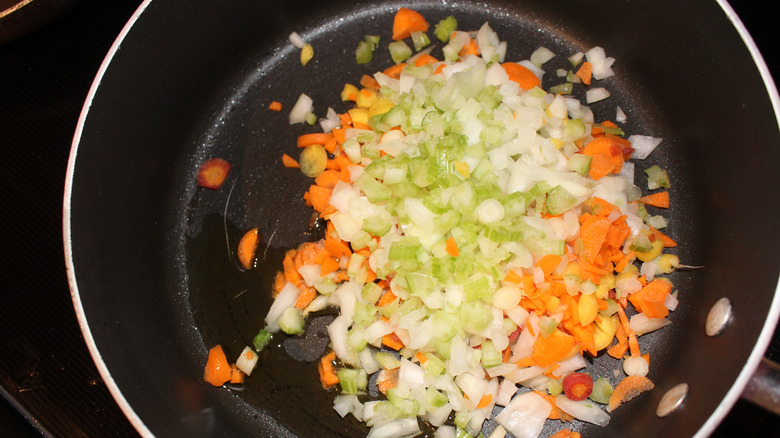What It Means When A Recipe Says To 'Sweat' Your Vegetables
Whether you're making soup, sauce, or one of your favorite hearty stews, you've probably noticed that most of these stovetop recipes begin with aromatic vegetables before adding the main ingredients. These veggies are critical in creating a delicious dish by producing subtle yet rich flavors and appetizing aromas. The way to create this flavorful base is to 'sweat' the aromatics.
Sweating refers to cooking chopped aromatic vegetables low and slow in a bit of oil or butter without browning them. This process coaxes out the natural oils and moisture from within the veggies resulting in a glossy appearance that looks like they are sweating, hence the name. The purpose of sweating vegetables is to soften them and extract their mellow flavors that enhance the taste of the other ingredients without overpowering them.
The most common vegetables to sweat are onions, celery, and carrots — a popular combination of ingredients known as mirepoix. You can add other aromatics to this triad, just make sure they're the kind with a high moisture content like shallots, garlic, zucchini, and bell pepper. It's important to note that some people use the terms sweat and saute interchangeably, however, these are two different processes. Unlike sweating, sauteing is done at high heat, involves browning the vegetables, and produces a finished dish.
How to sweat vegetables
The first step in sweating vegetables is preparing them. If you're making a mirepoix, you can use the common ratio of two parts onions, and one part celery and carrots. If adding other ingredients, decide on the amount based on the finished dish you're going to make. Clean, peel, and chop them into equally sized pieces to ensure even cooking.
Next, place a skillet or pan on the stove, add a little oil or butter according to your preference, and heat it at a low or medium-low setting. The target is to have the oil just slightly hot. Add in the vegetables and spread them out to avoid overcrowding. Cover the pan with a lid and allow the vegetables to cook slowly for 10 to 15 minutes. Stir the mixture regularly to encourage even cooking and prevent the veggies from browning or burning, and add salt and other seasonings to enhance the flavors. The salt will also help draw out moisture from the vegetables and boost the sweating process.
Once the veggies become soft and appear translucent (especially the onions) they're ready. The final step is to add them to the dish you're preparing. You can either add them whole, puree them, or pass them through a sieve to create a paste-like consistency that will blend well with the other ingredients.

